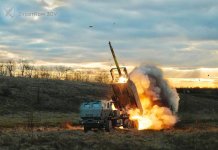Earlier this month, Canada announced plans to buy 88 F-35A Joint Strike Fighters (JSF) for CA$19 billion (US $14 billion).
No Abrams For Ukraine! Despite Repeated Plea, Why US Continues To Deny Its Main Battle Tanks To Kyiv?
In an online briefing, Canadian Defense Minister Anita Anand said that the Royal Canadian Air Force (RCAF) would receive its first four Lockheed Martin-made F-35s in 2026, with the following six in 2027 and another six in 2028. The remainder would come in subsequent years.
Anand also noted that this purchase will be the RCAF’s largest fleet investment in the last thirty years and is necessary considering Russia’s invasion of Ukraine and China’s “increasingly assertive behavior in the Indo-Pacific.”
These 88 new F-35A jets will replace the RCAF’s aging fleet of CF-18 Hornet, a variant of the American McDonnell Douglas F/A-18 Hornet, which has participated in numerous conflicts over the past two decades.
The first time the Canadian Hornets saw action was during the American-led Desert Storm campaigns in 1990-91, which is still remembered for how remarkably the Canadian Hornet took the fight to the enemy in an unconventional fashion.
Canadian Hornets Attack An Iraqi Patrol Boat
The CF-18 Hornet is a multirole combat aircraft that can be utilized for air defense, air superiority, tactical support, training, aerobatic examination, and aerospace testing and evaluation.
It is available in two variants, CF-18A and CF-18B, with the former being a single-seat combat and ground attack aircraft and the latter fitted with two seats in the cockpit for the pilot and co-pilot.
The CF-18 can carry 6,215 kilograms of payload, including rockets, bombs, fuel tanks, and gun pods. It has nine hard points, one under the fuselage, four on wing stations, two on the sides of the fuselage, and two on the wingtips.
The aircraft is equipped with a 20mm M61A1 Vulcan internal Gatling gun (578 rounds), capable of firing 4,000 to 6,000 munitions per minute. It can be fitted with various bombs such as Paveway, Mk 82, Mk 83, Mk 84, GBU-10, -12, -16, and -24 laser-guided bombs.

The aircraft can also carry AIM-9 Sidewinders, AIM-120 AMRAAM, and AIM-7 Sparrow air-to-air missiles, and its air-to-ground armament comprises AGM-65 Maverick and CRV7 rockets.
The CF-18 has no shortage of options for air-to-surface attacks. Yet, on the night of January 30, 1991, a formation of Canadian Hornet fighter jets attacked an Iraqi patrol boat with an AIM-7 Sparrow missile!
According to a report by AP News, 26 Royal Canadian Air Force (RCAF) CF-18 fighter jets and about 600 airmen and ground crew from the 1st Air Division based at Baden-Sollingen, Germany, took part in the 1991 war in Iraq.
According to a paper authored by Lieutenant-Colonel DE Molstad in fulfillment of a Master’s Dissertation for a course at Canadian Forces College, during the Desert Storm campaign, a large number of the 34 confirmed allied victories against fighter aircraft were scored by the US Air Force (USAF’s) F-15C Eagle, a pure air superiority fighter designed for defensive counter-air, sweep and escort missions.
Only three victories were claimed by multirole aircraft, which included the two US Navy F-18C Hornets and one by a US Navy F-14A Tomcat.

Whereas the Canadian multirole Hornets performed the combat air patrols (CAPs) to the south, where the Iraqi aircraft never went, while the sweep and escort missions occurred with air superiority already achieved
After two weeks of mundane CAPs, on the night of January 30, Captain Steve’ Hillbilly’ Hill and Major Dave ‘DW’ Kendall finally received a request from their shipborne controller: “Would you like to strafe a boat?” which they accepted without any hesitation.
The boat in question had escaped an American A-6 ‘Intruder’ when it ran out of ordnance.
After receiving final clearance to engage from their controller, the two Canadian pilots emptied their 20mm cannons over multiple strafing runs until they were finally left with only air-to-air missiles.
They then tried to acquire an infrared lock on the target to fire an AIM-9 Sidewinder missile. However, the boat’s heat signature was very low. Nevertheless, after some difficulty, ‘Hillbilly’ acquired a radar lock and fired an AIM-7 Sparrow semi-active radar missile at the boat.
The missile hit the water short of the target, and by that time, both pilots had returned to base. US bombers eventually neutralized the boat. However, the Canadians were officially awarded an ‘assist’ to its seaworthiness kill.
Senior military officials heaped praises at home on Hill and Kendall for their “example of Canadian can-do.”
However, the Commander of the Canadian Air Task Group – Middle East (CATGME), Colonel Roméo Lalonde, was not entirely happy about the attack. He conveyed to the press in the theater that the pilots should have made fewer passes to minimize their exposure.
Instead, they wasted a $250,000 air-to-air missile on a boat in the first offensive action by the Canadian military since the Korean War.
The engagement by the Canadian pilots was certainly unorthodox, but many officers in the fighter community viewed Lalonde’s criticisms as a little harsh.
After the attack, one Canadian official said, “We’re relieved to see some action finally. Soldiers don’t like to fight, but you naturally want to participate if everybody else is doing it.”
- Contact the author at tanmaykadam700@gmail.com
- Follow EurAsian Times on Google News




